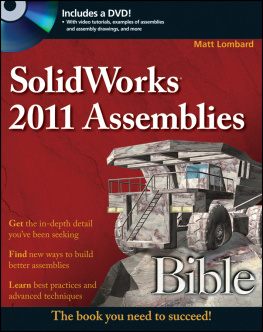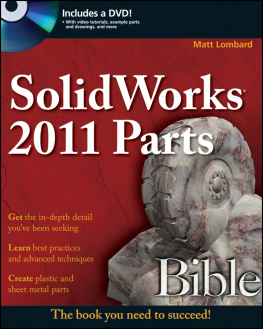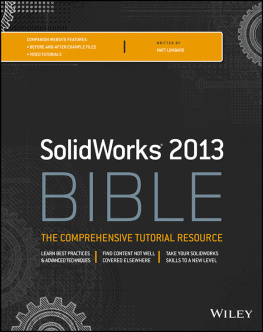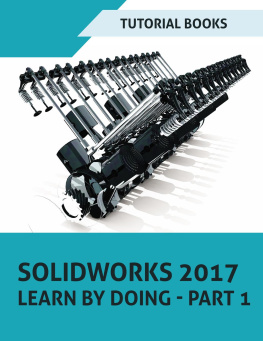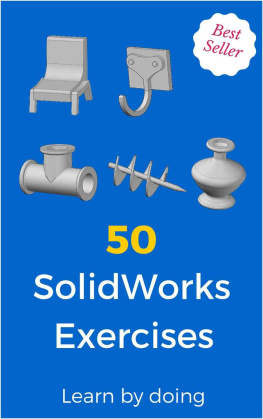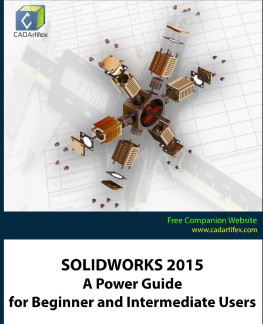SolidWorks 2011 Assemblies Bible
Matt Lombard
SolidWorks 2011 Assemblies Bible
Published by
Wiley Publishing, Inc.
10475 Crosspoint Boulevard
Indianapolis, IN 46256
www.wiley.com
Copyright 2011 by Wiley Publishing, Inc., Indianapolis, Indiana
Published by Wiley Publishing, Inc., Indianapolis, Indiana
Published simultaneously in Canada
ISBN: 978-1-118-00276-6
Manufactured in the United States of America
10 9 8 7 6 5 4 3 2 1
No part of this publication may be reproduced, stored in a retrieval system or transmitted in any form or by any means, electronic, mechanical, photocopying, recording, scanning or otherwise, except as permitted under Sections 107 or 108 of the 1976 United States Copyright Act, without either the prior written permission of the Publisher, or authorization through payment of the appropriate per-copy fee to the Copyright Clearance Center, 222 Rosewood Drive, Danvers, MA 01923, (978) 750-8400, fax (978) 646-8600. Requests to the Publisher for permission should be addressed to the Permissions Department, John Wiley & Sons, Inc., 111 River Street, Hoboken, NJ 07030, 201-748-6011, fax 201-748-6008, or online at http://www.wiley.com/go/permissions .
Limit of Liability/Disclaimer of Warranty: The publisher and the author make no representations or warranties with respect to the accuracy or completeness of the contents of this work and specifically disclaim all warranties, including without limitation warranties of fitness for a particular purpose. No warranty may be created or extended by sales or promotional materials. The advice and strategies contained herein may not be suitable for every situation. This work is sold with the understanding that the publisher is not engaged in rendering legal, accounting, or other professional services. If professional assistance is required, the services of a competent professional person should be sought. Neither the publisher nor the author shall be liable for damages arising herefrom. The fact that an organization or Website is referred to in this work as a citation and/or a potential source of further information does not mean that the author or the publisher endorses the information the organization or Website may provide or recommendations it may make. Further, readers should be aware that Internet Websites listed in this work may have changed or disappeared between when this work was written and when it is read.
For general information on our other products and services or to obtain technical support, please contact our Customer Care Department within the U.S. at (877) 762-2974, outside the U.S. at (317) 572-3993 or fax (317) 572-4002.
Library of Congress Control Number: 2011932103
Trademarks: Wiley and related trade dress are registered trademarks of Wiley Publishing, Inc., in the United States and other countries, and may not be used without written permission. SolidWorks is a registered trademark of Dassault Systmes SolidWorks Corporation. All other trademarks are the property of their respective owners. Wiley Publishing, Inc., is not associated with any product or vendor mentioned in this book.
Wiley also publishes its books in a variety of electronic formats. Some content that appears in print may not be available in electronic books.
About the Author
Matt Lombard is an independent engineering consultant specializing in plastic parts and complex shapes. He also writes a blog on SolidWorks, which you can find at www.dezignstuff.com/blog . Matt lives in the picturesque Shenandoah Valley of Virginia, where he enjoys reading the classics and fishing.
Credits
Senior Acquisitions Editor
Stephanie McComb
Project Editor
Jade L. Williams
Technical Editor
Charles Culp
Copy Editor
Marylouise Wiack
Editorial Director
Robyn Siesky
Business Manager
Amy Knies
Senior Marketing Manager
Sandy Smith
Vice President and Executive Group Publisher
Richard Swadley
Vice President and Executive Publisher
Barry Pruett
Senior Project Coordinator
Kristie Rees
Graphics and Production Specialists
Ana Carillo
Jill A. Proll
Quality Control Technician
Laura Albert
Proofreading
Christine Sabooni
Indexing
BIM Indexing & Proofreading Services
Media Development Project Manager
Laura Moss
Media Development Assistant Project Manager
Jenny Swisher
Media Development Associate Producer
Marilyn Hummel
Acknowledgments
I would like to acknowledge the efforts of the staff at Wiley for their dedication in editing the text of these books. It can be a difficult job making sure that a technical subject is treated properly. I'd also like to thank Charles Culp, the technical editor, for taking the time out of his schedule to make sure the material is accurate. Thanks also to Kim and Zoey, who help with the details in life allowing me to do this kind of work.
Introduction
SolidWorks is a huge, sprawling topic. There is a lot for you, the reader, to know, and for me to write about. As a result, with the 2011 edition, I have taken this book from a single volume of an immense scope to two individual volumes, each still fairly large, one covering parts and part drawings, and the other covering assemblies and assembly drawings. There is some overlap between these topics, but I have tried to divide the material evenly and in a way, that makes the most sense for the reader. Depending on your needs, you will probably find both volumes to be very useful references.
This book is primarily meant as an encyclopedic desk reference for SolidWorks Standard users who want a more thorough understanding of the software and process than can be found in other available documentation. As such, it is not necessarily intended to be a guide for beginners, although it has elements that beginners would find useful. Nor is it necessarily intended as a classroom guide, but I have seen people use it for that as well.
Beginners will find the step-by-step tutorials useful. However, because you are only a beginner for a short period of time, the book is intended to be most useful when you reach an intermediate level, as it takes a more conceptual approach to explaining functionality. I try to help you make the decisions about how to apply the tools to your tasks rather than demonstrating simple tasks that you will never need to do again. You will not learn to model a teapot in this book, because in your work, knowing how to model a teapot will probably not help you. However, you will learn how to make decisions that should enable you to model just about anything you want, including teapots.
To keep the size of the book manageable, I have tried to avoid topics found only in SolidWorks Professional or Premium, although I do talk about these topics when they are relevant.
While the book does point out limitations, bugs, and conceptual errors in the software, and from time to time ventures into the realm of opinion, in every case this is meant to give you a more thorough understanding of the software, and how it is applied in the context of everyday design or engineering practice.
The overall goal of this book is not to fill your head with facts, but to help you think like the software, so that you can use the tool as an intuitive extension of your own process. As your modeling projects become more complex, you will need to have more troubleshooting and work-around skills available to you. Along with best practice recommendations, these are the most compelling reasons to use this book.

